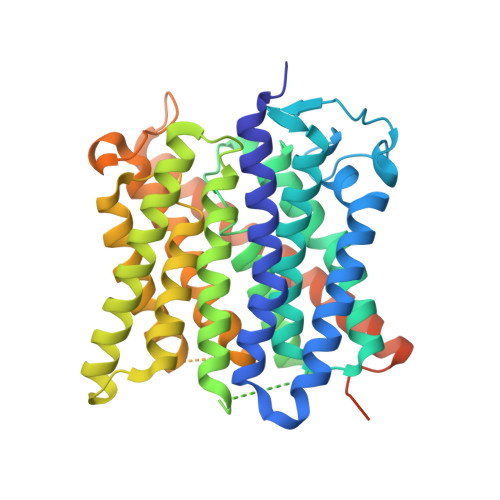Substrate binding, deprotonation, and selectivity at the periplasmic entrance of the Escherichia coli ammonia channel AmtB.
Javelle, A., Lupo, D., Ripoche, P., Fulford, T., Merrick, M., Winkler, F.K.(2008) Proc Natl Acad Sci U S A 105: 5040-5045
- PubMed: 18362341
- DOI: https://doi.org/10.1073/pnas.0711742105
- Primary Citation of Related Structures:
3C1G, 3C1H, 3C1I, 3C1J - PubMed Abstract:
The conduction mechanism of Escherichia coli AmtB, the structurally and functionally best characterized representative of the ubiquitous Amt/Rh family, has remained controversial in several aspects. The predominant view has been that it facilitates the movement of ammonium in its uncharged form as indicated by the hydrophobic nature of a pore located in the center of each subunit of the homotrimer. Using site-directed mutagenesis and a combination of biochemical and crystallographic methods, we have investigated mechanistic questions concerning the putative periplasmic ammonium ion binding site S1 and the adjacent periplasmic "gate" formed by two highly conserved phenylalanine residues, F107 and F215. Our results challenge models that propose that NH(4)(+) deprotonation takes place at S1 before NH(3) conduction through the pore. The presence of S1 confers two critical features on AmtB, both essential for its function: ammonium scavenging efficiency at very low ammonium concentration and selectivity against water and physiologically important cations. We show that AmtB activity absolutely requires F215 but not F107 and that removal or obstruction of the phenylalanine gate produces an open but inactive channel. The phenyl ring of F215 must thus play a very specific role in promoting transfer and deprotonation of substrate from S1 to the central pore. We discuss these results with respect to three distinct mechanisms of conduction that have been considered so far. We conclude that substrate deprotonation is an essential part of the conduction mechanism, but we do not rule out net electrogenic transport.
Organizational Affiliation:
Biomolecular Research, Paul Scherrer Institut, CH-5232 Villigen, Switzerland.

















